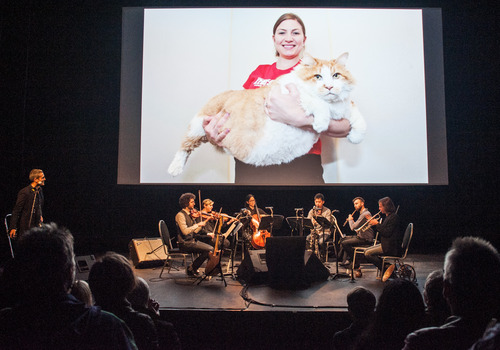
Sam Green is a documentary filmmaker, whose documentary The Weather Underground was nominated for an Academy Award and included in the 2004 Whitney Biennial. His recent focus is on “live documentaries”, including Utopia in Four Movements, The Love Song of R. Buckminster Fuller, and his recent film, The Measure of All Things.
His latest “live documentary”, The Measure of All Things, based on the Guinness Book of Records, will be shown at The Kitchen in New York City, November 21 and 22nd. The first night will feature a live soundtrack by yMusic and the second night with trio Brendan Canty (Fugazi), T Griffin, and Catherine McRae. I’ve always loved Green’s curious, open sensibility, and long been interested in how he finds and then explores his disparate subjects. We chatted by Skype. Like a true filmmaker, he commented on how nice the light looked in my San Francisco living room.
—Anisse Gross
I. FALLING IN LOVE AND GOING LIVE
THE BELIEVER: I would love to know how you fell into making documentaries in the first place. When you were younger, were you in art school, or a journalist?
SAM GREEN: If you look back on your life, things seem easy to predict, but at the time you just stumble into things. It made no sense how I got into what I’m doing at the time, but now I can see that it makes sense. As a kid I was super obsessive and interested in the world. I’d get very into different subjects—I was really into Big Foot for many years. I’d draw lots of pictures of Big Foot and correspond with people who had seen Big Foot when I was like eight years old. In hindsight I can see that I was basically getting obsessed and doing research.
When I went to college, I went to art school, but it felt too cut off from the world, especially the art world in the 80s. Then I went to UC Berkeley graduate school of journalism, and took a video class on a whim. The class was taught by the great documentary filmmaker Marlon Riggs. All I knew about documentaries was the boring stuff I had seen on PBS, but Marlon’s work and the other work in the class, like Sans Soleil by Chris Marker, or Salesman by the Maysles—all these fantastic films that combine lyricism and poetry with a rigorous journalistic approach. Those things put together—I was smitten by that.
BLVR: It’s nice to get into a field by accident; it’s like falling in love. You can’t really plan for it.
SG: No, not at all. When I was in my twenties, I really wanted to...
You have reached your article limit
Sign up for a digital subscription and continue reading all new issues, plus our entire archives, for just $1.50/month.
Already a subscriber? Sign in




